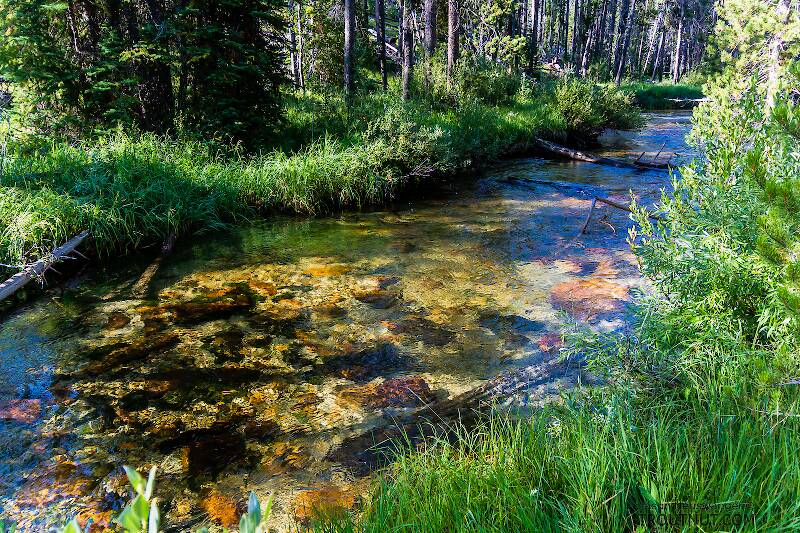
Blue-winged Olives
Baetis
Tiny Baetis mayflies are perhaps the most commonly encountered and imitated by anglers on all American trout streams due to their great abundance, widespread distribution, and trout-friendly emergence habits.
Featured on the forum

I was not fishing, but happened to be at an unrelated social event on a hill above this tiny creek (which I never even saw) when this stonefly flew by me. I assume it came from there. Some key characteristics are tricky to follow, but process of elimination ultimately led me to Sweltsa borealis. It is reassuringly similar to this specimen posted by Bob Newell years ago. It is also so strikingly similar to this nymph from the same river system that I'm comfortable identifying that nymph from this adult. I was especially pleased with the closeup photo of four mites parasitizing this one.

Troutnut is a project started in 2003 by salmonid ecologist Jason "Troutnut" Neuswanger to help anglers and
fly tyers unabashedly embrace the entomological side of the sport. Learn more about Troutnut or
support the project for an enhanced experience here.
Wbranch on Dec 26, 2010December 26th, 2010, 11:56 pm EST
Hello Spence,
""Spence. Have you ever noticed just how much we are just waiting around?!"
I agree that often one has to wait for bugs to emerge before we can ply our dry fly offerings. But I'm okay with waiting for the bugs to emerge and start to see the rythmic rise forms of the trout.
My initial forays into fly fishing were mostly nymph based. I nymphed my butt off for at least thirty years. I was high sticking before it even had a name and many times could just sense a trout had eaten the nymph and I'd lift and feel the throbbing of the rod.
There was no time where I suddenly said "I'm done with nymphs" but more of a gradual cessation of looking for good nymph runs and one of looking for rise forms. I think much of my change from nymphing to dries ocurred when I stopped fishing the Beaverkill and Willowemoc where the numbers of trout are quite high per mile. I felt much more confident while nymphing those rivers that there were good numbers of trout in the riffles that would see my nymph.
The rivers I prefer to fish now appear to have far fewer trout per mile (excluding Montana) and I prefer to sit on the bank, or wait in my drift boat, for the rises to start. I still will nymph hard for steelhead and I still enjoy tying lots of nymphs. I also often hang a nymph off the bend of my dry fly on a piece of tippet 6" - 10" long.
""Spence. Have you ever noticed just how much we are just waiting around?!"
I agree that often one has to wait for bugs to emerge before we can ply our dry fly offerings. But I'm okay with waiting for the bugs to emerge and start to see the rythmic rise forms of the trout.
My initial forays into fly fishing were mostly nymph based. I nymphed my butt off for at least thirty years. I was high sticking before it even had a name and many times could just sense a trout had eaten the nymph and I'd lift and feel the throbbing of the rod.
There was no time where I suddenly said "I'm done with nymphs" but more of a gradual cessation of looking for good nymph runs and one of looking for rise forms. I think much of my change from nymphing to dries ocurred when I stopped fishing the Beaverkill and Willowemoc where the numbers of trout are quite high per mile. I felt much more confident while nymphing those rivers that there were good numbers of trout in the riffles that would see my nymph.
The rivers I prefer to fish now appear to have far fewer trout per mile (excluding Montana) and I prefer to sit on the bank, or wait in my drift boat, for the rises to start. I still will nymph hard for steelhead and I still enjoy tying lots of nymphs. I also often hang a nymph off the bend of my dry fly on a piece of tippet 6" - 10" long.
Catskill fly fisher for fifty-five years.
Quick Reply
Related Discussions
Topic
Replies
Last Reply
1
Mar 9, 2012
by Wiflyfisher
by Wiflyfisher
13
Apr 12, 2007
by Greyghost
by Greyghost
4
Dec 30, 2011
by Troutfly
by Troutfly


